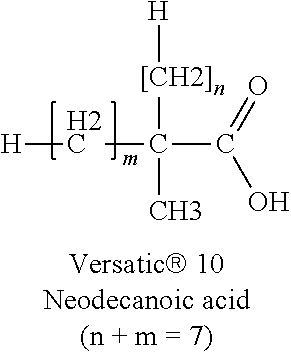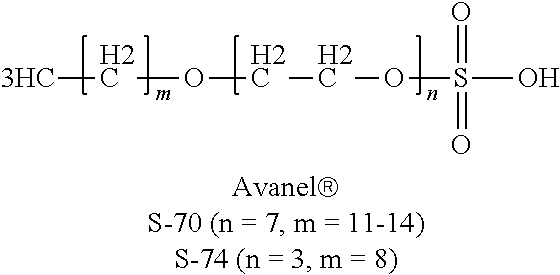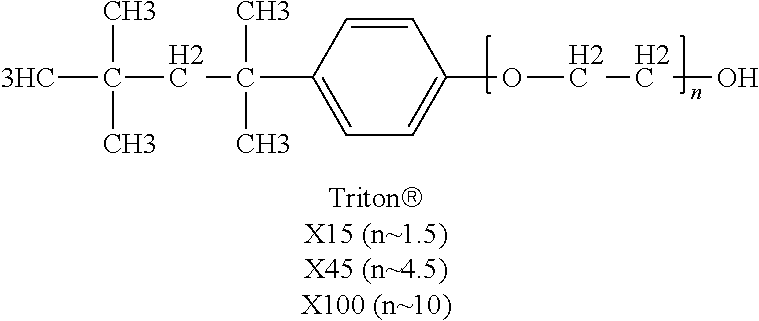Fluoropolymer Resin Treatment Employing Oxidizing Agent to Reduce Discoloration
- Summary
- Abstract
- Description
- Claims
- Application Information
AI Technical Summary
Benefits of technology
Problems solved by technology
Method used
Image
Examples
example 6
FEP, pH 10, NaOH, H2O, Ozone, 3 Hours@50 C
[0254]Aqueous FEP dispersion polymerized as described above is diluted to 5 weight percent solids with deionized water and preheated to 50° C. in a water bath. 1200 ml of the FEP dispersion is titrated with 9 drops of 50% NaOH to increase the pH to 10. 2 ml of 30 wt % H2O2 is added. [0.97 wt % H2O2 to polymer]. The dispersion is transferred to a 2000 ml jacketed glass reactor with internal diameter of 13.3 cm (5¼ inches), which has 50° C. water circulating through the reactor jacket. An impeller with four 3.18 cm (1.25 inch) long flat blades set at a 45° angle and two injection tubes that each have a 12 mm diameter by 24 mm long, fine-bubble, fritted-glass cylinder produced by LabGlass as part number 8680-130 are placed in the reactor. The agitator is set at 60 rpm. Each injection tube is connected to an AQUA-6 portable ozone generator manufactured by A2Z Ozone of Louisville, Ky. The ozone generators are turned on and used to bubble 1.18 sta...
example 1
Oxidative Reactive Extrusion of FEP
[0322]Aqueous FEP dispersion polymerized as described above is coagulated in a heated glass reactor. 1250 ml of dispersion is heated to 85° C. in a water bath and then transferred to a 2,000 ml jacketed glass reactor with four internal baffles produced by Lab Glass or Vineland, N.J. where the temperature is maintained at by circulating 85° C. water through the jacket. Two high-shear impellers are turned at 2,470 rpm for 3600 seconds to cause the dispersion to separate into a polymer phase and a water phase. The water is separated from the solids by filtering through a 150 micron mesh filter bag model NMO150P1SHS manufactured by The Strainrite Companies of Auburn, Me. The polymer phase is dried for 40 hours in a circulating air oven set at 150° C. to produce a dry powder.
[0323]A sample of dried powder is molded to produce color films as described in the Test Methods section above as Measurement of Thermally Induced Discoloration for melt-processible...
example 1a
PTFE PTFE, Dried with Ozone at 1 Power
[0338]A quantity of PTFE Dispersion as described above is diluted to 5 wt % solids with deionized water. The dispersion is coagulated and isolated via the method described above (Coagulation and Isolation of PTFE Dispersion). Polymer thus obtained is then dried at 170° C. for 1 hour using the PTFE drier described above (Apparatus for Drying of PTFE Polymer). During the hour of drying, 100 cc / min of ozone enriched air is introduced into the dryer. Ozone is produced by passing 100 cc / min of air into a Clearwater Technologies, Inc. Model CD-10 ozone generator which is operated at ½ power setting. Dried polymer is characterized as described in the Test Methods Measurement of Thermally Induced Discoloration for PTFE. L* obtained for this polymer is 63.7 with a % change in L* of 45.6% indicating a much improved color after treatment. The measured color is shown in Table 1.
PUM
| Property | Measurement | Unit |
|---|---|---|
| Fraction | aaaaa | aaaaa |
| Volume | aaaaa | aaaaa |
| Wettability | aaaaa | aaaaa |
Abstract
Description
Claims
Application Information
 Login to View More
Login to View More - R&D
- Intellectual Property
- Life Sciences
- Materials
- Tech Scout
- Unparalleled Data Quality
- Higher Quality Content
- 60% Fewer Hallucinations
Browse by: Latest US Patents, China's latest patents, Technical Efficacy Thesaurus, Application Domain, Technology Topic, Popular Technical Reports.
© 2025 PatSnap. All rights reserved.Legal|Privacy policy|Modern Slavery Act Transparency Statement|Sitemap|About US| Contact US: help@patsnap.com



